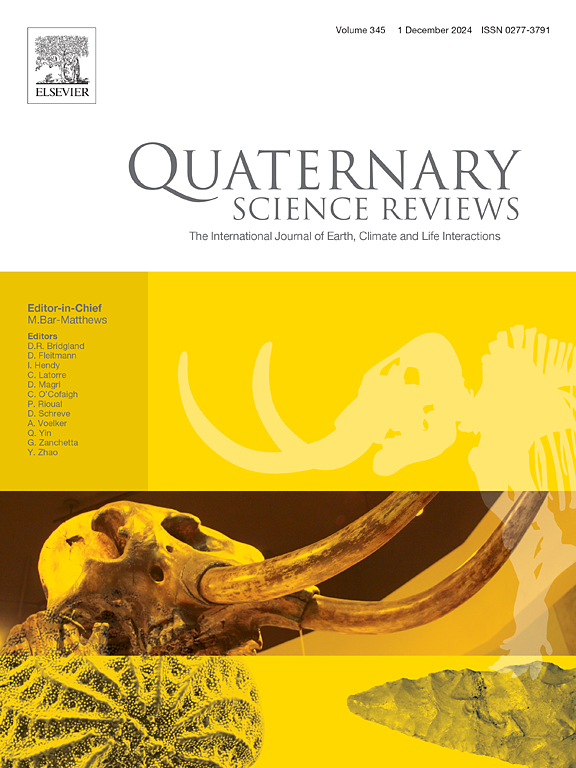Fossil spring records from central Sudan reveal paleoenvironmental and settlement dynamics in the Eastern Sahel during the last 30 ka
IF 3.2
1区 地球科学
Q1 GEOGRAPHY, PHYSICAL
引用次数: 0
Abstract
Knowledge of past environmental change and prehistoric settlement dynamics in the Sahel east of the Nile is limited due to the scarcity of suitable sedimentary archives and archaeological sites. Here we present tufa-based paleoenvironmental records from the area of NW Butana (central Sudan, ∼55 km southeast of the Nile River) which show that increased rainfall and spring activity occurred in several discrete intervals during the last ∼30,000 years. Lithostratigraphic data combined with phytolith, malacological, paleopedological, and stable carbon isotope records revealed humidity peaks during late MIS3 and the early and middle Holocene. Gaps in lithological records correlated with dry periods of the Last Glacial Maximum and Younger Dryas. Minor wet pulses coinciding with Late Glacial interstadials indicate an early intensification of the African monsoon, which implies that a sharp climatic boundary existed between the Sahel and the Sahara during this period.
These new paleoenvironmental records, together with archaeological evidence from Butana, provide a unique opportunity for understanding human ecology in the eastern Sahel. The peoples who inhabited this dryland area 30+ km from the Nile Valley could not rely on its relatively predictable resources of riverine, floodplain and lake habitats. New models of subsistence and settlement, and strategies of adaptations to seasonal and interannual environmental variability are needed.
苏丹中部的泉水化石记录揭示了过去 30 ka 年间东萨赫勒地区的古环境和定居动态
由于缺乏合适的沉积档案和考古遗址,人们对尼罗河以东萨赫勒地区过去的环境变化和史前定居动态的了解十分有限。在这里,我们展示了来自西北布塔纳地区(苏丹中部,尼罗河东南 55 公里处)基于页岩的古环境记录,这些记录显示,在过去的 3 万年中,降雨量和春季活动在几个不连续的时间段内有所增加。岩石地层学数据与植物岩石学、苹果学、古生物学和稳定碳同位素记录相结合,揭示了 MIS3 晚期以及全新世早期和中期的湿度高峰。岩性记录的间隙与末次冰川极盛期和幼年干旱期的干旱期相关。与晚冰川期间歇期相吻合的小湿潮表明非洲季风的早期加强,这意味着在这一时期萨赫勒和撒哈拉之间存在着一个明显的气候边界。居住在这片距离尼罗河谷 30 多公里的干旱地区的人们无法依赖其相对可预测的河流、洪泛平原和湖泊栖息地资源。需要新的生存和定居模式,以及适应季节性和年际性环境变化的战略。
本文章由计算机程序翻译,如有差异,请以英文原文为准。
求助全文
约1分钟内获得全文
求助全文
来源期刊

Quaternary Science Reviews
地学-地球科学综合
CiteScore
7.50
自引率
15.00%
发文量
388
审稿时长
3 months
期刊介绍:
Quaternary Science Reviews caters for all aspects of Quaternary science, and includes, for example, geology, geomorphology, geography, archaeology, soil science, palaeobotany, palaeontology, palaeoclimatology and the full range of applicable dating methods. The dividing line between what constitutes the review paper and one which contains new original data is not easy to establish, so QSR also publishes papers with new data especially if these perform a review function. All the Quaternary sciences are changing rapidly and subject to re-evaluation as the pace of discovery quickens; thus the diverse but comprehensive role of Quaternary Science Reviews keeps readers abreast of the wider issues relating to new developments in the field.
 求助内容:
求助内容: 应助结果提醒方式:
应助结果提醒方式:


